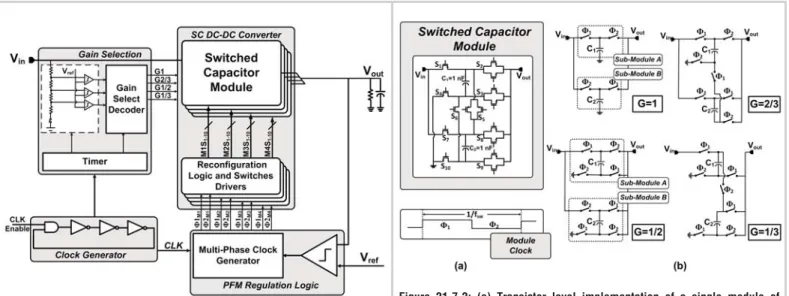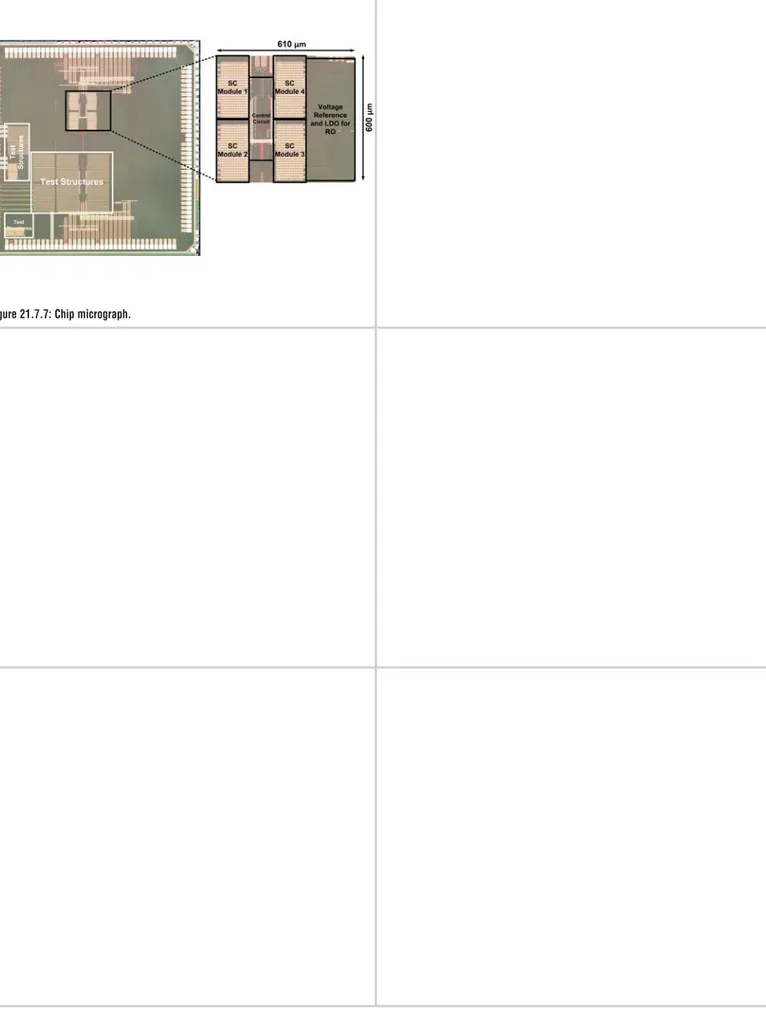A 93% efficiency reconfigurable switched-capacitor
DC-DC converter using on-chip ferroelectric capacitors
The MIT Faculty has made this article openly available.
Please share
how this access benefits you. Your story matters.
Citation
El-Damak, D., S. Bandyopadhyay, and A. P. Chandrakasan. “A 93%
Efficiency Reconfigurable Switched-Capacitor DC-DC Converter
Using on-Chip Ferroelectric Capacitors.” 2013 IEEE International
Solid-State Circuits Conference Digest of Technical Papers
(February 17-21, 2013), San Francisco, CA.
As Published
http://dx.doi.org/10.1109/ISSCC.2013.6487776
Publisher
Institute of Electrical and Electronics Engineers (IEEE)
Version
Author's final manuscript
Citable link
http://hdl.handle.net/1721.1/95416
Terms of Use
Creative Commons Attribution-Noncommercial-Share Alike
A 93% Efficiency Reconfigurable Switched-Capacitor
DC-DC Converter Using On-Chip Ferroelectric
Capacitors
Dina El-Damak, Saurav Bandyopadhyay, Anantha P. Chandrakasan
Massachusetts Institute of Technology, Cambridge, MA
Dynamic Voltage Scaling (DVS) has become one of the standard techniques for energy efficient operation of systems by powering circuit blocks at the minimum voltage that meets the desired performance [1]. Switched Capacitor (SC) DC-DC converters have gained significant interest as a promising candidate for an inte-grated energy conversion solution that eliminates the need for inductors [2,3]. However, SC converters efficiency is limited by the conduction loss, bottom plate parasitic capacitance, gate drive loss in addition to the overhead of the con-trol circuit. Reconfigurable SC converters supporting multi-gain settings have been proposed to allow efficient operation across wide output range [2,4]. Also, High density deep trench capacitors with low bottom plate parasitic capacitance have been utilized in [5] achieving a peak efficiency of 90%. In this work, we exploit on-chip ferroelectric capacitors (Fe-Caps) for charge transfer owing to their high density and extremely low bottom plate parasitic capacitance [6]. High efficiency conversion is achieved by combining the Fe-Caps with multi-gain set-ting converter in a reconfigurable architecture with dynamic gain selection. Figure 21.7.1 shows the top level architecture of the whole power management IC. It consists of reconfigurable switched capacitor DC-DC converter split in four modules (M1-M4) that are interleaved for output voltage ripple reduction [3,4],
pulse frequency modulation (PFM) regulation logic, clock generator, gain selec-tion block that include programmable low duty cycle timers, and a voltage refer-ence. The transistor level implementation of the SC module is shown in Figure 21.7.2a which can be reconfigured for four gain settings (1-2/3-1/2-1/3) as shown in Fig. 21.7.2b. Each module consists of two charge transfer capacitors, 1nF each, and ten switches. Since the implementation of gain settings (2/3, 1/3) requires two capacitors while (1,1/2) can be achieved with one only, thus, for the latter each module is reconfigured into two identical sub-modules running with 180 degree phase shifted clocks for further ripple reduction.
The losses due to the bottom plate parasitic capacitance of on-chip capacitors usually limit the peak efficiency of the converter. These losses occur as SC con-verters supply power to the load through the charge and discharge of flying capacitors (C1and C2). A direct non-desirable impact to this process is the
charge and discharge of the bottom plate parasitic capacitance, αC, every clock cycle [2]. As an example, for gain setting 1/2, the converter charges C1to (Vin
-Vout) in phase 1 and discharges it to Voutin phase 2. In companion to this
process the bottom plate capacitance gets charged to Vout and discharged to
ground wasting an energy of αC1Vout2 per cycle where α is technology
depend-ent (the same process applied for capacitor C2 but with the reverse order of
phases). Highly efficient conversion is achieved by utilizing the ferroelectric capacitors, that posses extremely low bottom plate parasitics, for charge trans-fer. In addition, the architectures utilized for each gain setting are selected to minimize the voltage swing across the bottom plate capacitors for maximizing efficiency. Since the output load current is directly proportional to the capaci-tance of the flying caps [8], therefore, the Fe-Caps high density allows for sup-plying the power demands of the load without a highly significant area overhead. Figure 21.7.3a depicts the control logic for the converter output voltage regula-tion. The PMIC employs a PFM modulation scheme using a Strong-Arm com-parator running at fCLKwhich is 4 times the maximum desired switching speed,
fsw. The comparator output is fed into cascaded clock dividers and non-overlap
clock generators for providing the multi-phase control signals for the four mod-ules of the converter [7]. The comparator clock is generated on-chip using a ring oscillator (RO) with external digital calibration. The voltage reference can be pro-vided externally or internally using on-chip reference with embedded resistor string DAC.
Each configuration of the switched capacitor DC-DC converter can supply an output voltage lower than the no-load voltage (VNL) which is equal to the input
voltage multiplied by the gain setting [2]. Thus, the converter gain is selected based on the ratio of the reference to the input voltage as shown in Fig. 21.7.3b where the latter is applied to a resistor string to generate three intermediate
volt-age levels Vin/3, Vin/2, 2Vin/3. Dynamic comparators and gain select decoder are utilized to configure the converter for the proper gain. In order to minimize the power consumption of the gain selection block, NMOS footer switch N1 is used to avoid static power consumption in the resistor string. The control sig-nals (GCtrl1, GCtrl2) of the gain selection block are generated internally using programmable timers. First GCtrl1 is applied to turn on the footer switch N1 as shown in Fig. 21.7.3b. The dynamic comparators are commanded to enter the evaluation mode using GCtrl2 after sufficient time that allows their negative input terminals to settle to the desired values. After the gain decoder block has stored the outputs of the comparators, the footer switch is turned off for power saving. The whole PMIC runs from the input supply and doesn’t need any external volt-age sources other than the reference in comparison with previous work [2,3] which required an external additional supply.
Figure 21.7.4a shows the measured efficiency of the PMIC versus the output voltage. The system achieves a peak efficiency of 93% including the control overhead while supplying 500μA at an output voltage of 0.963V and a peak of 92% while supplying 1mA. The SC DC-DC converter alone achieves a peak of 94% while supplying a load current of 500μA. An off-chip output capacitor of 10nF was utilized while performing the measurements. Figure 21.7.4b depicts the measured overall efficiency of the IC versus the output load current at the peak efficiency point while using a comparator clock of 8.2MHz. The control cir-cuit power consumption impact the efficiency for load currents below 100μA which can be mitigated by scaling the comparator clock speed with the output load current [2]. Figure 21.7.5 shows the measured transient response of the system while stepping the reference from 0.95V to 0.45V. The output voltage tracks the reference voltage while gain hopping is performed from gain setting 2/3 to 1/3 to maximize the converter efficiency. Figure 21.7.6 shows a compari-son of the performance of the PMIC presented to previously published work. The system is fabricated in 0.13μm CMOS and occupies an area of 600×610μm2as
shown in Fig. 21.7.7.
The work advances the state of the art by achieving a bench mark for switched capacitor DC-DC converters with on-chip capacitors reporting a 93% peak effi-ciency including the control overhead which well exceeds all the previous report-ed work [3].
Acknowledgment:
The chip fabrication was provided by Texas Instruments. The authors thank Scott Summerfelt for technical discussion and Raj Aggarwal and Dennis Buss for their support.
References:
[1] B. Calhoun and A. Chandrakasan, “Ultra-Dynamic Voltage Scaling using Sub-threshold Operation and Local Voltage Dithering in 90nm CMOS,” IEEE ISSCC
Dig. Tech. Papers, pp. 300-301, Feb. 2005.
[2] Y. Ramadass and A. Chandrakasan, “Voltage Scalable Switched Capacitor DC-DC Converter for Ultra-Low-Power On-Chip Applications,” IEEE Power
Electronics Specialists Conference , pp. 2353-2359, June 2007.
[3] G. Villar Piqué, “A 41-Phase Switched-Capacitor Power Converter with 3.8mV Output Ripple and 81% Efficiency in Baseline 90nm CMOS,” IEEE ISSCC
Dig. Tech. Papers, pp. 98-101, Feb. 2012.
[4] H.-P. Le, et al., “A 32nm Fully-Integrated Reconfigurable Switched-Capacitor DC-DC Converter Delivering 0.55W/mm2 at 81% Efficiency,” IEEE ISSCC Dig.
Tech. Paper, pp. 210-212, Feb. 2010.
[5] L. Chang, et al., “A Fully-Integrated Switched-Capacitor 2:1 Voltage Converter with Regulation Capability and 90% Efficiency at 2.3 A/mm2,” IEEE
Symp. VLSI Circuits, pp. 55-56, June 2010.
[6] H. P. McAdams, et al., “A 64-Mb Embedded FRAM Utilizing a 130-nm 5LM Cu/FSG Logic Process”, IEEE Journal of Solid-State Circuits, vol. 39, pp. 667-677, April 2004.
[7] T. Breussegem and M. Steyaert, “A 82% Efficiency 0.5% Ripple 16-Phase Fully Integrated Capacitive Voltage Doubler,” IEEE Symp. VLSI Circuits, pp. 198-199, June 2009.
[8] Y. Ramadass, et al., “A 0.16mm2Completely On-Chip Switched-Capacitor
Converter using Digital Capacitance Modulation for LDO Replacement in 45nm CMOS,” IEEE ISSCC Dig. Tech. Paper, pp. 208-209, Feb. 2010.
Figure 21.7.1: Top level architecture of the Power Management IC (PMIC).
Figure 21.7.2: (a) Transistor level implementation of a single module of the switched capacitor (SC) DC-DC converter (b) Reconfiguration of the SC module for various gain settings (1,2/3,1/2,1/3).
Figure 21.7.3: (a) Pulse Frequency Modulation (PFM) control logic for output voltage regulation of the multi-phased converter (b) Gain select block architecture and timing diagram.
Figure 21.7.5: Measured load transient performance of the PMIC with a step in the reference voltage from 0.95 V to 0.45 V while showing the gain hopping
from 2/3 to 1/3. Figure 21.7.6: Performance summary and comparison.
Figure 21.7.4: (a) Measured overall efficiency of the Power management IC (PMIC) while delivering 500μA and 1mA and measured efficiency of the switched-capacitor DC-DC converter alone while delivering 500μA. (b) Measured efficiency the PMIC versus load current while supplying an output voltage of 0.96V at a comparator clock of 8.2MHz.

